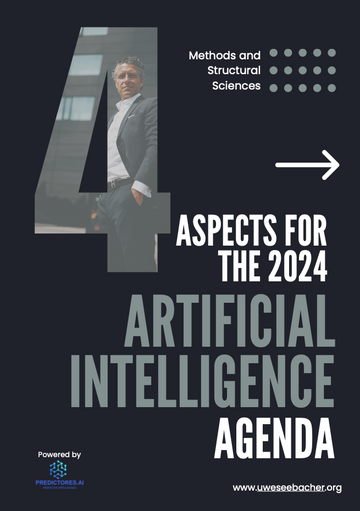
In today's digital age, artificial intelligence (AI) is not just a tool; it's a pivotal component in driving business innovation and efficiency. Uwe Seebacher's 2024 AI Agenda highlights the essential role of AI in modern business, emphasizing the need for AI literacy and a deep understanding of its capabilities and limitations.

Fig. 1: AI is not more than a calculator whereas PI is the GPS and the roadmap (Source: DALLE-E, Predictores 2023)
AI as a Tool, Not a Solution
AI, akin to a calculator or steering wheel, requires human intelligence to steer its course. Seebacher reminds us that AI, without proper context, cannot create substantial economic value. It's not about having AI; it's about how you use it. This distinction is critical in leveraging AI to achieve real business outcomes.
In simpler terms, I recently talked to a new business owner who hired an AI expert to develop their AI technology. However, when I asked about his business model, the data he was using, the challenges he faced, and what he wanted the AI to do, he couldn't answer. I explained to him that without a clear purpose or connection to his business goals, hiring an AI expert is like wasting money. It's like hiring someone to use a calculator without knowing what problem they're solving – they might produce results, but these results won't necessarily be useful or add value to his business.

Fig. 2: Methods and Structural Sciences as the key to PI
(Source: DALLE-E, Predictores 2023)
The Rise of Predictive Intelligence (PI)
Predictive Intelligence (PI) is the next frontier. It's like the GPS to AI's steering wheel, providing real-time insights for better decision-making. Integrating AI with PI involves aligning AI initiatives with business objectives, ensuring they resonate with organizational culture, and establishing clear metrics for success.
As I delve deeper into the concepts of AI and Predictive Intelligence in my work, particularly highlighted in my bestseller, I focus on the synergy between these two technologies. In my perspective, understanding the basics of AI and Predictive Intelligence is the starting point. It's vital to align these technologies with business objectives, ensuring they resonate with organizational culture and contribute meaningfully to decision-making processes.
My roadmap for integrating AI and PI involves:
-
Building Knowledge: Gaining a deep understanding of AI and PI, as I discuss in my book, is essential for everyone in the organization.
-
Strategic Alignment: I emphasize aligning AI initiatives with business goals, ensuring they drive real value.
-
Cultural Integration: It's crucial to create a culture that embraces AI and PI, weaving these technologies into the business fabric.
-
Effective Data Management: As I often highlight, data is the lifeblood of AI and PI. Developing a strong data strategy is key to success.
-
Metrics for Success: Establishing clear metrics is important to track the success of AI and PI initiatives.
-
Continuous Learning and Adaptation: The landscape of AI and PI is ever-evolving, and staying updated is imperative.
Through my book and ongoing research, I aim to provide a comprehensive guide to businesses and individuals seeking to harness the power of AI and Predictive Intelligence.

Fig. 3: Blurred PI dashboard for OEM supplier
(Source: Predictores.ai, 2023)
Building a Data-Driven Culture
In a world awash with data, the challenge lies not in data accumulation but in its intelligent analysis and application. AI and data specialists must collaborate closely with business experts to interpret data meaningfully. This contextual understanding transforms data from mere numbers to actionable insights.





